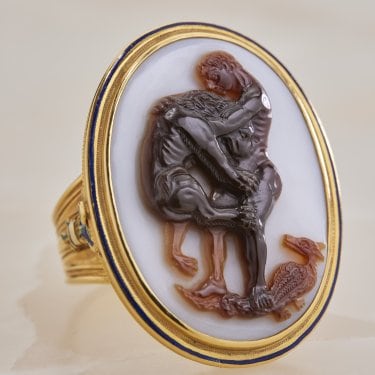
As a child, I first stood fascinated in front of a very similar cameo, perhaps by the same Sicilian lapidary artist, in the court circle of Frederick II, Holy Roman Emperor, in the Metropolitan Museum. It is not the least bit surprising that the glyptic (the word itself of Greek origin!) artists have celebrated Hercules all through time. The glyptic arts have always been the highly esteemed, sought after witnesses from the past. Ghiberti boasted far more in his Memorii about cameos for which he made mountings upon Medici commissions than he did about his Baptistry doors. As Michael Lewis said in his Princeton University thesis: during the Italian Renaissance, cameos and intaglios were treasured because they bore history’s messages for those who sought so intensely to understand it, learn from it and move forward with it.
Of course, glyptic artists of our past, celebrating Antiquity, picked Hercules as a favorite subject. We find this first labor of Hercules on many ancient coins. Hercules, whose name means “in praise of Hera”, is the lifelong victim of Hera’s rage, because Zeus fathered him surreptitiously with Alcmene. Descendant of Perseus, half human, half god, he resonates forever, from Antiquity to the minds of today’s children who know him through cartoons.
This gorgeous piece is carved so that the brown Hercules and almost translucent lion rise from a white base, the brown layer having been exquisitely cut away by a 13th century lapidary to reveal the scene. Look at the serene expression on the face of the hero, and the giant paws and claws gripping his heavily muscled legs. The claws of the Nemean lion could cut through all metal and armor, which is why he used one of the lion’s claws to flay the lion in order to obtain the skin, which forever becomes his protective attribute. He stands on a basilic, a weird reptile-rooster combination, dating from Antiquity, which has nothing to do with the Greek myth, a typically delightful medieval add-on.
Photo : Sicily, XIIIth century, Hercules slaying the lion, Sardonyx cameo on an enamelled gold ring, Collection Guy Ladrière, Photo Benjamin Chelly

